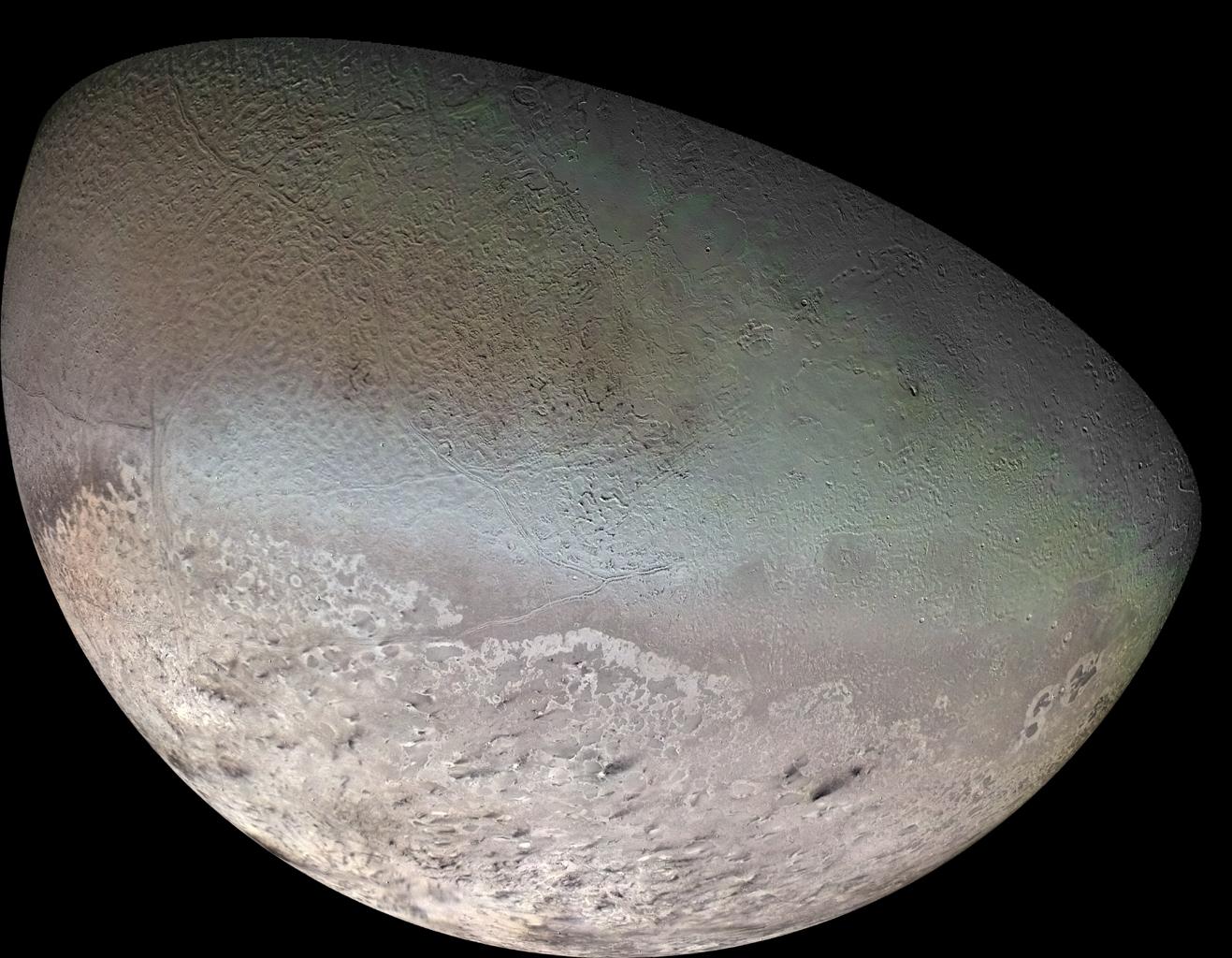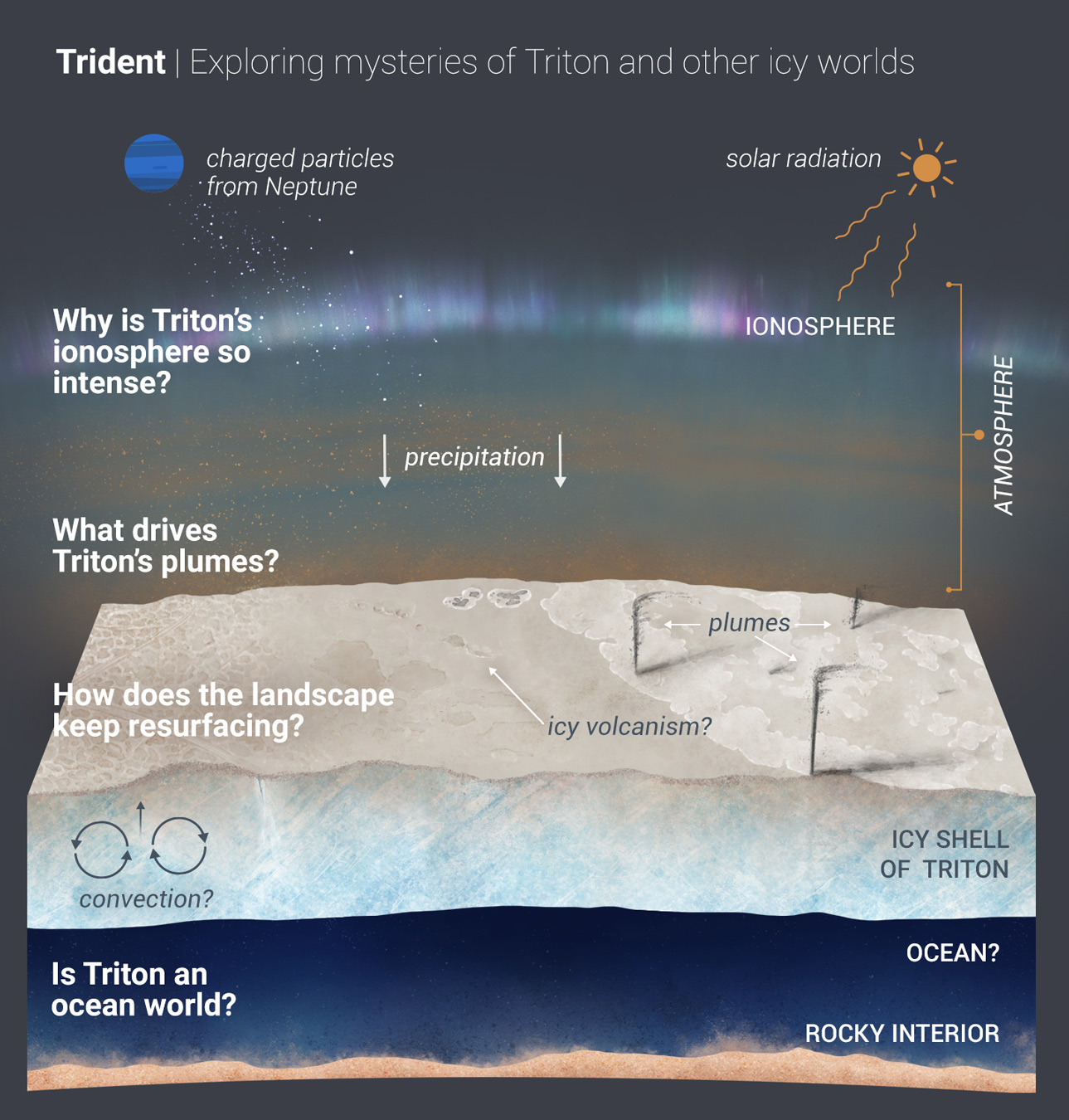Neptune's weird moon Triton could get a visit from a NASA spacecraft called Trident

A possible new mission called Trident aims to explore Neptune's strange moon Triton.
Neptune's largest moon, Triton boasts an uncommon icy mixture on its surface, among other unique characteristics that could help scientists learn more about how bodies in the solar system evolved. Trident is one of four mission concepts competing in a current round of NASA's Discovery program, which develops relatively low-cost robotic-exploration efforts.
The proposed Trident mission — named for its three-pronged approach to solving Triton's mysteries, inspired by the three-pronged spear carried by the ancient Roman sea god Neptune — plans to visit Triton and study the moon's entire surface in greater detail, according to a statement from NASA.
Related: NASA unveils best map ever of Neptune's moon Triton (images, video)
"Triton has always been one of the most exciting and intriguing bodies in the solar system," Louise Prockter, director of the Lunar and Planetary Institute of the Universities Space Research Association in Houston, who leads the Trident proposal team, said in the statement. "I've always loved the Voyager 2 images and their tantalizing glimpses of this bizarre, crazy moon that no one understands."
NASA's Voyager 2 spacecraft launched in 1977 to study the outer planets. Voyager 2 is the only spacecraft ever to have flown past Neptune, the most distant planet in the solar system. The mission captured stunning views of the planet and its moons, but also left a lot of unanswered questions about the distant planetary system. If Trident is selected, it will be Voyager 2's first successor to Neptune.
Under NASA's Discovery program, up to two of the concept missions currently in development will be selected by summer 2021 for launch later in the decade. (Previously selected missions in the Discovery program include the InSight Mars lander, the Kepler Space Telescope and the Messenger spacecraft to Mercury.)
Get the Space.com Newsletter
Breaking space news, the latest updates on rocket launches, skywatching events and more!
Triton is the seventh largest moon in our solar system. Scientists believe it was born in the Kuiper Belt — the region beyond Neptune full of icy bodies left over from the early solar system — before it migrated to its current position orbiting the gas giant.
Triton has many other unusual characteristics of interest. It is the only moon in the solar system that orbits in the opposite direction of its planet's rotation, and its path around the planet lies at an extreme tilt, offset from Neptune's equator by 23 degrees.
The moon also has an unusual atmosphere and a dynamic climate. The moon's ionosphere is filled with charged particles and is 10 times more active than that of any other moon in the solar system. Generally, ionospheres are charged by solar energy. However, considering Triton and Neptune are 30 times farther from the sun than Earth is, there must be another energy source here, according to the statement.
"Triton is weird, but yet relevantly weird, because of the science we can do there," Karl Mitchell, Trident project scientist at NASA's Jet Propulsion Laboratory in California, said in the statement. "We know the surface has all these features we've never seen before, which motivates us to want to know 'How does this world work?"
The Trident mission's first goal is to study Triton's strange icy plumes — a feature scientists believe is caused by water from the interior being forced through the moon's thick, icy crust. If Trident finds a subsurface ocean is the source of the plumes on Triton, the discovery would expand scientists' understanding of where water might be found beyond Earth.

The Trident mission also aims to map the largest unexplored solid surface in the solar system this side of the Kuiper Belt. So far, scientists have seen only 40% of Triton's surface. Using a full-frame imaging camera, Trident would aim to map the rest by taking advantage of the sun's reflected light as it illuminates Neptune.
Lastly, the mission aims to study the moon's surface in greater detail. Triton has almost no visible craters, suggesting the moon's surface is a relatively young landscape that has been resurfaced over and over with fresh material.
"As we said to NASA in our mission proposal, Triton isn't just a key to solar system science — it's a whole keyring: a captured Kuiper Belt object that evolved, a potential ocean world with active plumes, an energetic ionosphere and a young, unique surface," Mitchell said in the statement.
If selected, Trident would launch in October 2025 (with October 2026 as a backup date). At this time, Earth will align with Jupiter so that the spacecraft can use the gravitational pull of Jupiter as a slingshot. Trident would then arrive at Triton in 2038 for an extended 13-day encounter. Scientists are calling this timing "a once-in-a-13-year window," according to the statement.
With the Trident mission, scientists hope to learn more about how Triton has changed over time. Such knowledge, in turn, would provide a better understanding of how planets and moons in the solar system have evolved.
- Neptune's moon Triton has a rare kind of ice
- Mysterious 'sub-Neptunes' are probably water worlds
- Does Planet Nine really exist?
Follow Samantha Mathewson @Sam_Ashley13. Follow us on Twitter @Spacedotcom and on Facebook.
OFFER: Save 45% on 'All About Space' 'How it Works' and 'All About History'!
For a limited time, you can take out a digital subscription to any of our best-selling science magazines for just $2.38 per month, or 45% off the standard price for the first three months.
Join our Space Forums to keep talking space on the latest missions, night sky and more! And if you have a news tip, correction or comment, let us know at: community@space.com.

Samantha Mathewson joined Space.com as an intern in the summer of 2016. She received a B.A. in Journalism and Environmental Science at the University of New Haven, in Connecticut. Previously, her work has been published in Nature World News. When not writing or reading about science, Samantha enjoys traveling to new places and taking photos! You can follow her on Twitter @Sam_Ashley13.
-
kristianna276 They say that being determines consciousness. I am utterly amazed by the real images captured by the Explorers, Hubble, Opportunity, Spirit and other such observatories and probes. The Explorer fly-by was awesome. We are the first generation that have real images of what the planets are like in our own solar system. Unfortunately, until we touch these place they are not part of our day to day reality. It is great for NASA to send a Trident to Triton, so we can have a better understanding of a major moon of Neptune. I know that there has been talk of sending a probe to Europa, maybe there should be a watery series of probes to see if these moons can be harvested for their watery content. If would more economical to be able to harvest water from the moons of Triton, Europa and Io, than to spend grinding water out of Luna rocks. NASA needs to ask, where will we want to be in the next 100 years? How do we envision ourselves in the next 50? What do we need to do in order to get there?Reply -
Dave Maza 13 years??? I’m really hoping the next generation of heavy lift vehicles can shorten these travel times a bit.Reply -
Space Robot So how is it an “extended 13-day encounter”? Is it a fast fly-by like Pluto? It would be great to stay and explore for a longer time.Reply -
kristianna276 Reply
the time it takes to travel from Earth to Mars is dependent on where the planet it is. We orbit the sun faster than the planet Mars where the window of opportunity exists once ever thirteen months. It is like shooting a target your passing, and aiming at a spot where it will be; not where it is. If we get there before the planet Mars gets there, then we will overshoot the plant and will be headed toward Jupiter; an even slower planet. Can we shorten the window of opportunity? It takes six months to get to Mars, if it would take four months to get to Mars; where will the planet be in four months? How fast will be have to travel; and how long would it take for us to stop? Mars has a thin atmosphere and a week gravity. The faster we go; the harder it is to stop. Unless you want to slam dance onto the Martian surface.Dave Maza said:13 years??? I’m really hoping the next generation of heavy lift vehicles can shorten these travel times a bit. -
rkramp I thought of something, for sending probes to the outer planets, like for orbiting them, that's planets Uranus, Neptune and Pluto. That can of course also be for going to Neptune's moon Triton. I would have mentioned it in the Uranus Orbiter? thread, but it was closed for comments.Reply
With current technology of rockets and probes, these need to have large retro-boosters attached to them. That's because of those planets being so distant. Planet Uranus for instance is about seven times further from the sun than planet Jupiter, and planet Neptune about twice as far as planet Uranus. So, when approaching the destination, the retro-boosters fire, in order to slow it down into orbit, and falling down into the planet. The retro-boosters then detaching. The probes could also have coverings over them, with the boosters attached to those. When the boosters detach, the coverings also do.
When the Horizons probe went to planet Pluto it was going too fast to go into orbit, so just did a flyby, and it still took nine years. So, having wanted it to be going slow to go into orbit, probably would have taken about 24 years - way too long. Hence, those booster rockets for such orbital probes. -
Lovethrust The SLS could get a nuclear powered orbiter to Neptune in around 3 years if my memory serves correctly!Reply










